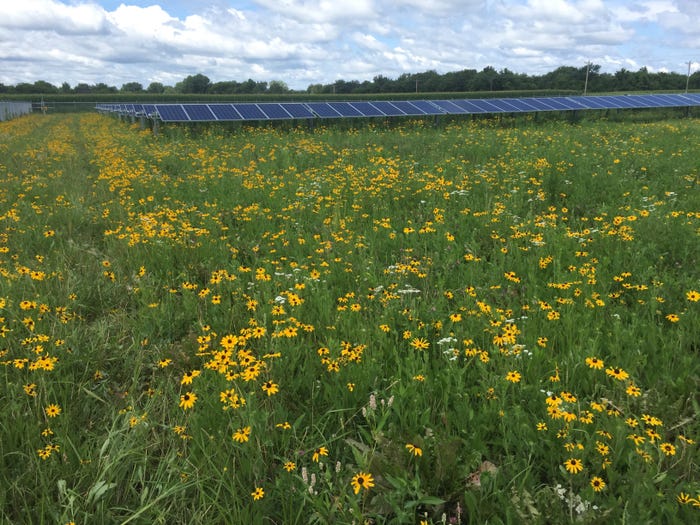Organic Valley aims high: 100 percent renewably powered by 2019
With an impressive investment in wind and solar, Organic Valley is poised to become the largest food company in the world that is 100 percent renewably powered. Learn how your company can—and should—follow in their footsteps.
October 18, 2018

Organic Valley has held lofty sustainability goals for years, but the 2,000+ member cooperative kept growing at a rate that outpaced their energy supply. While a solution proved elusive at first, after much research the company has collaborated with their local utilities and developer OneEnergy Renewables to form a first-of-its-kind community solar partnership that’s a model to emulate.
In addition to securing land leases and background permitting, OneEnergy soon will introduce a long-term owner/operator that plans to break ground in November 2018 on 10 solar farms in Wisconsin, Minnesota and Iowa, benefitting a combined rural population of roughly 25,000. Organic Valley’s Head of Sustainability Jonathan Reinbold says the best part is “knowing that this project is serving the communities of the Upper Midwest, displacing coal electricity with clean solar…as well as [being advantageous] economically for Organic Valley and our farmers, employees and neighbors that live and work within the region.”
So how does it all work? Organic Valley commits to purchasing renewable energy credits (RECs) that come off those solar farms for the next 25 years, while the utilities sign power purchase agreements (PPAs) to buy the power during that time frame. “Those two commitments together,” says Reinbold, “allow the project to be financially viable.” And the cost isn’t as great as you might think. “In year one and year two, we see a nominally higher electricity cost to the business, but by year three we’re saving money,” reveals Reinbold. He goes on to share that because Organic Valley has for years been budgeting for increased electricity rates, product pricing will not be impacted, which is good news for the company’s customer base.
Organic Valley spends approximately $1M a year on total electricity; roughly two percent of that figure—$20,000—would be a cost premium in the first two years. For an organization with topline revenue just over $1B, “We’re talking about 0.1 percent of topline that we spend on electricity,” admits Reinbold. “It’s not cost-prohibitive if you find the right partner.”
On that topic of partnership, the cooperative is in further good company with the support of iconic natural products brand Dr. Bronner’s, also on board with the 100 percent renewable effort. “We’ve installed a significant solar array at our headquarters,” says Cosmic Engagement Officer David Bronner, “but it only covers 50 percent of our needs.” As such, his company has committed to purchasing RECs from an Organic Valley/OneEnergy project to be built in Minnesota, allowing Dr. Bronner’s to meet their 100 percent renewable goal this year. “We looked around and couldn’t find good local partners,” shares Darcy Shiber-Knowles, Senior Quality, Sustainability & Innovation Manager for Dr. Bronner’s, “but we could find an amazing national partner in Organic Valley, with full traceability and other benefits.”
 Organic Valley’s Reinbold says there are numerous reasons for going 100 percent renewable: cost control, fulfilling consumer expectations around values and mitigating the agricultural industry’s contribution to climate change, to name a few. His advice for companies just starting out? “If you don’t have any experience with renewables procurement, certainly understanding what your needs are should be the first thing you do…just seeing what your electricity consumption is over the course of a year.” Reinbold credits the Sustainable Food Trade Association (SFTA), along with its Climate Collaborative initiative (of which Organic Valley is a founding member), as excellent resources to help companies track their sustainability efforts. He also encourages those wanting to take the renewables leap to contact him directly. “There’s nothing proprietary about helping another company figure out how to engage their utility…we’re happy to share all of our learnings.”
Organic Valley’s Reinbold says there are numerous reasons for going 100 percent renewable: cost control, fulfilling consumer expectations around values and mitigating the agricultural industry’s contribution to climate change, to name a few. His advice for companies just starting out? “If you don’t have any experience with renewables procurement, certainly understanding what your needs are should be the first thing you do…just seeing what your electricity consumption is over the course of a year.” Reinbold credits the Sustainable Food Trade Association (SFTA), along with its Climate Collaborative initiative (of which Organic Valley is a founding member), as excellent resources to help companies track their sustainability efforts. He also encourages those wanting to take the renewables leap to contact him directly. “There’s nothing proprietary about helping another company figure out how to engage their utility…we’re happy to share all of our learnings.”
Speaking to the ROI on sustainability, Reinbold admits that “there’s still a bit of a stigma associated with it, that sustainability activities are a cost to the business. That was true maybe 5-10 years ago, when it was definitely at a premium to the conventional option, but it’s just not true anymore…a less-than-three-year return on investment should be a pretty easy decision for most companies to make.”
About the Author
You May Also Like




